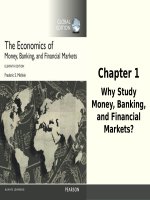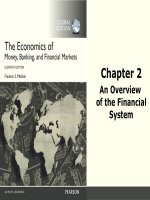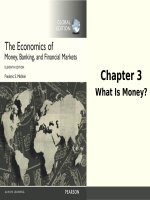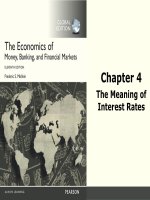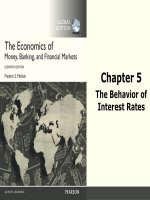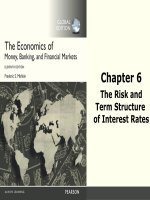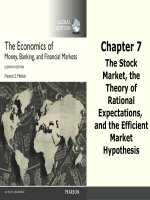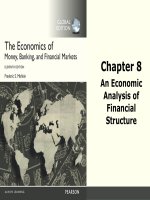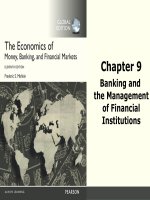The economics of money, banking, and financial institutions (11th edition) by f s mishkin ch2 an overview of the financial system
Bạn đang xem bản rút gọn của tài liệu. Xem và tải ngay bản đầy đủ của tài liệu tại đây (1.05 MB, 20 trang )
Chapter 2
An Overview
of the Financial
System
20-1
© 2016 Pearson Education Ltd. All rights reserved.
Preview
• This chapter presents an overview of the
study of financial markets and institutions.
1-2
© 2016 Pearson Education Ltd. All rights reserved.
Learning Objectives
• Compare and contrast direct and indirect
finance.
• Identify the structure and components of
financial markets.
• List and describe the different types of
financial market instruments.
• Recognize the international dimensions of
financial markets.
1-3
© 2016 Pearson Education Ltd. All rights reserved.
Learning Objectives
• Summarize the roles of transaction costs,
risk sharing, and information costs as they
relate to financial intermediaries.
• List and describe the different types of
financial intermediaries.
• Identify the reasons for and list the types of
financial market regulations.
1-4
© 2016 Pearson Education Ltd. All rights reserved.
Function of Financial Markets
• Performs the essential function of
channeling funds from economic players
that have saved surplus funds to those that
have a shortage of funds
• Direct finance: borrowers borrow funds
directly from lenders in financial markets by
selling them securities
1-5
© 2016 Pearson Education Ltd. All rights reserved.
Function of Financial Markets
• Promotes economic efficiency by producing
an efficient allocation of capital, which
increases production
• Directly improve the well-being of
consumers by allowing them to time
purchases better
1-6
© 2016 Pearson Education Ltd. All rights reserved.
Figure 1 Flows of Funds Through
the Financial System
1-7
© 2016 Pearson Education Ltd. All rights reserved.
Structure of Financial Markets
• Debt and Equity Markets
– Debt instruments (maturity)
– Equities (dividends)
• Primary and Secondary Markets
– Investment banks underwrite securities in
primary markets.
– Brokers and dealers work in secondary
markets.
1-8
© 2016 Pearson Education Ltd. All rights reserved.
Structure of Financial Markets
• Exchanges and Over-the-Counter (OTC)
Markets:
– Exchanges: NYSE, Chicago Board of Trade
– OTC markets: Foreign exchange, Federal funds
• Money and Capital Markets:
– Money markets deal in short-term debt
instruments
– Capital markets deal in longer-term debt and
equity instruments
1-9
© 2016 Pearson Education Ltd. All rights reserved.
Financial Market Instruments
1-10
© 2016 Pearson Education Ltd. All rights reserved.
Financial Market Instruments
1-11
© 2016 Pearson Education Ltd. All rights reserved.
Internationalization of Financial
Markets
• Foreign Bonds: sold in a foreign country and
denominated in that country’s currency
• Eurobond: bond denominated in a currency other
than that of the country in which it is sold
• Eurocurrencies: foreign currencies deposited in
banks outside the home country
– Eurodollars: U.S. dollars deposited in foreign banks
outside the U.S. or in foreign branches of U.S. banks
• World Stock Markets:
– Also help finance the federal government
1-12
© 2016 Pearson Education Ltd. All rights reserved.
Function of Financial
Intermediaries: Indirect Finance
• Lower transaction costs (time and money
spent in carrying out financial transactions)
– Economies of scale
– Liquidity services
• Reduce the exposure of investors to risk
– Risk Sharing (Asset Transformation)
– Diversification
1-13
© 2016 Pearson Education Ltd. All rights reserved.
Function of Financial
Intermediaries: Indirect Finance
• Deal with asymmetric information problems:
– Adverse Selection (before the transaction): try
to avoid selecting the risky borrower by gathering
information about them
– Moral Hazard (after the transaction): ensure
borrower will not engage in activities that will
prevent him/her to repay the loan.
• Sign a contract with restrictive covenants.
1-14
© 2016 Pearson Education Ltd. All rights reserved.
Function of Financial
Intermediaries: Indirect Finance
• Conclusion:
– Financial intermediaries allow “small” savers and
borrowers to benefit from the existence of
financial markets.
1-15
© 2016 Pearson Education Ltd. All rights reserved.
Types of Financial Intermediaries
1-16
© 2016 Pearson Education Ltd. All rights reserved.
Types of Financial Intermediaries
1-17
© 2016 Pearson Education Ltd. All rights reserved.
Regulation of the Financial System
• To increase the information available to
investors:
– Reduce adverse selection and moral hazard
problems
– Reduce insider trading (SEC)
1-18
© 2016 Pearson Education Ltd. All rights reserved.
Regulation of the Financial System
• To ensure the soundness of financial
intermediaries:
– Restrictions on entry (chartering process).
– Disclosure of information.
– Restrictions on Assets and Activities (control
holding of risky assets).
– Deposit Insurance (avoid bank runs).
– Limits on Competition (mostly in the past):
• Branching
• Restrictions on Interest Rates
1-19
© 2016 Pearson Education Ltd. All rights reserved.
Regulation of the Financial System
1-20
© 2016 Pearson Education Ltd. All rights reserved.
